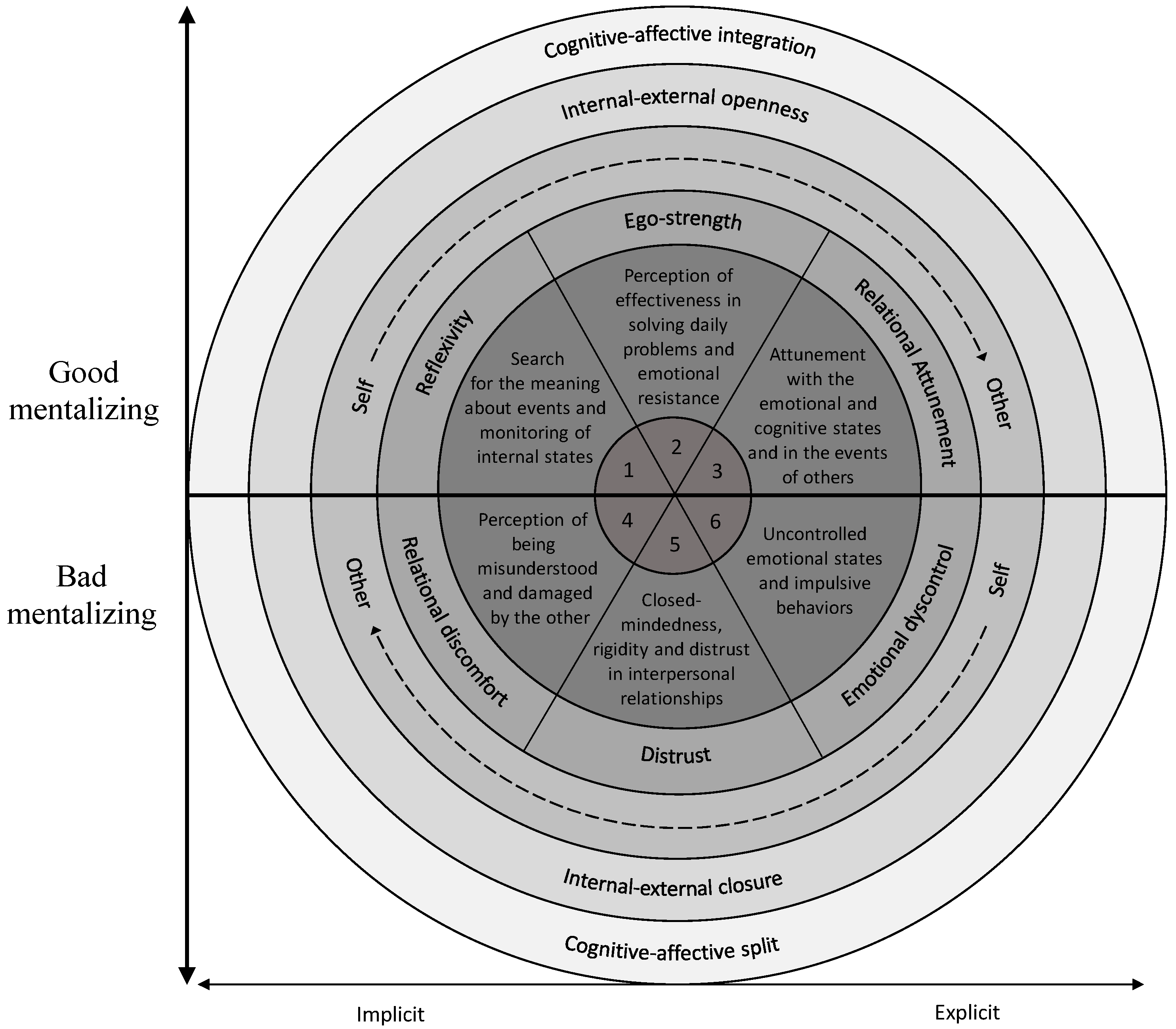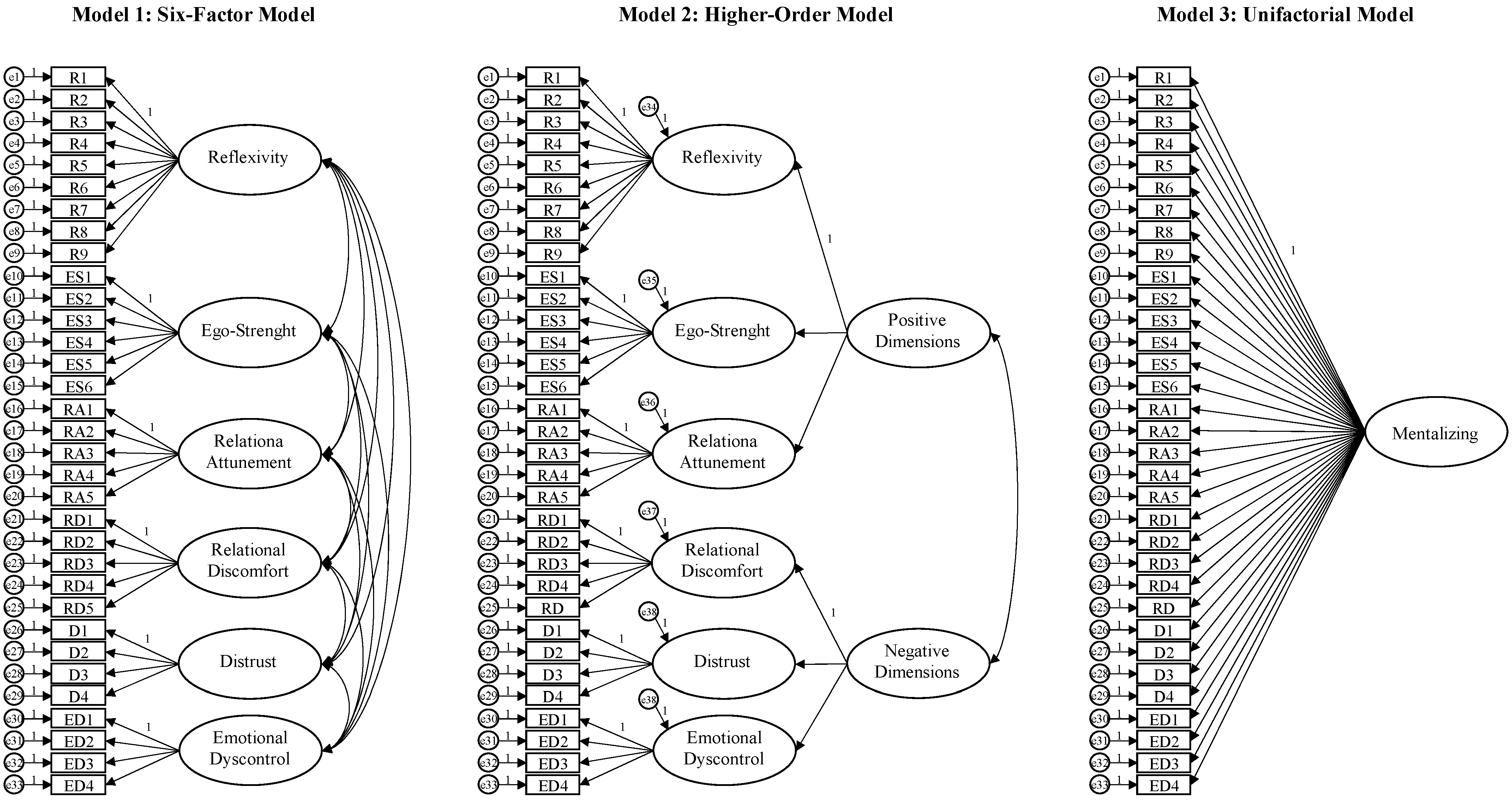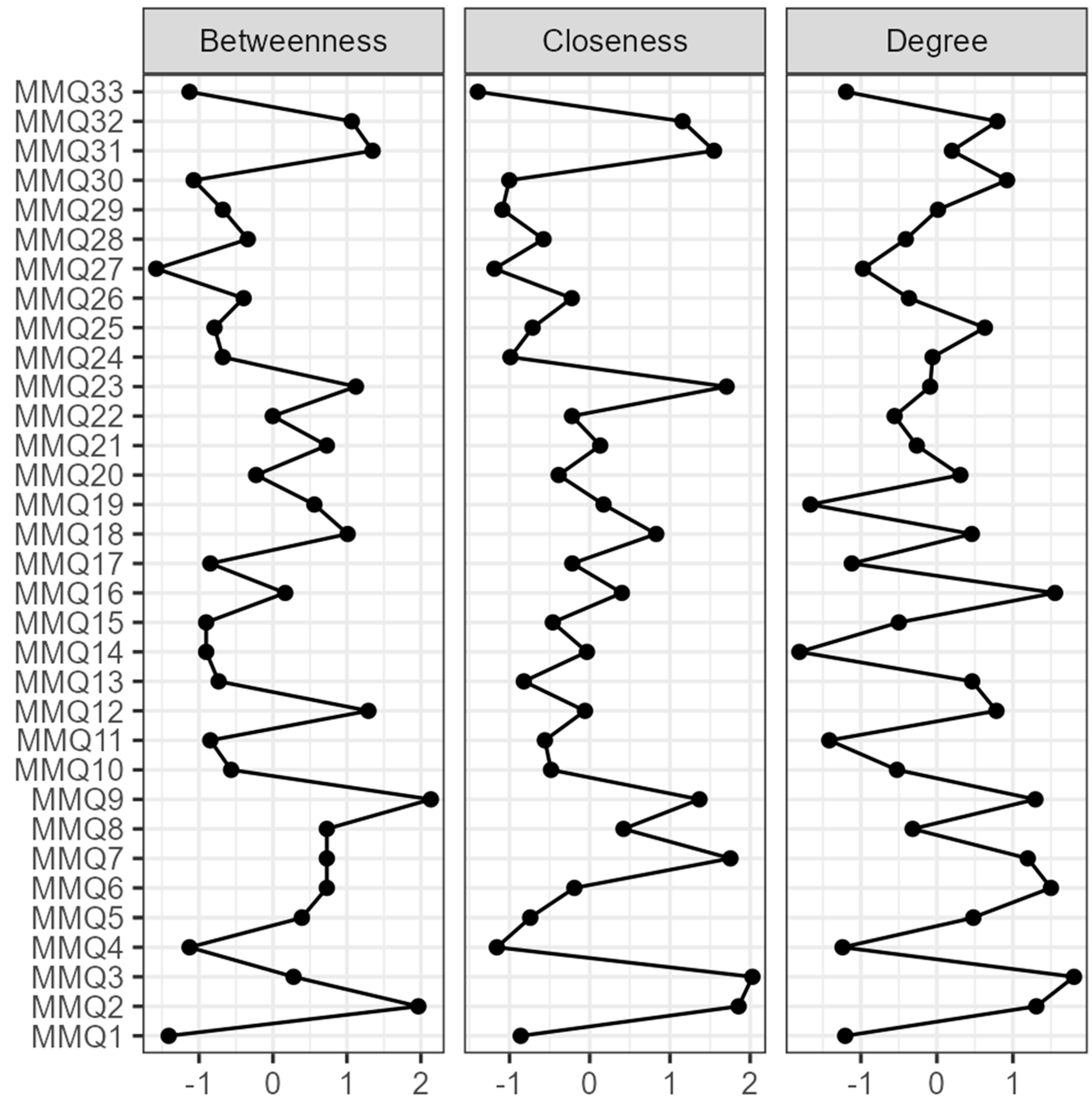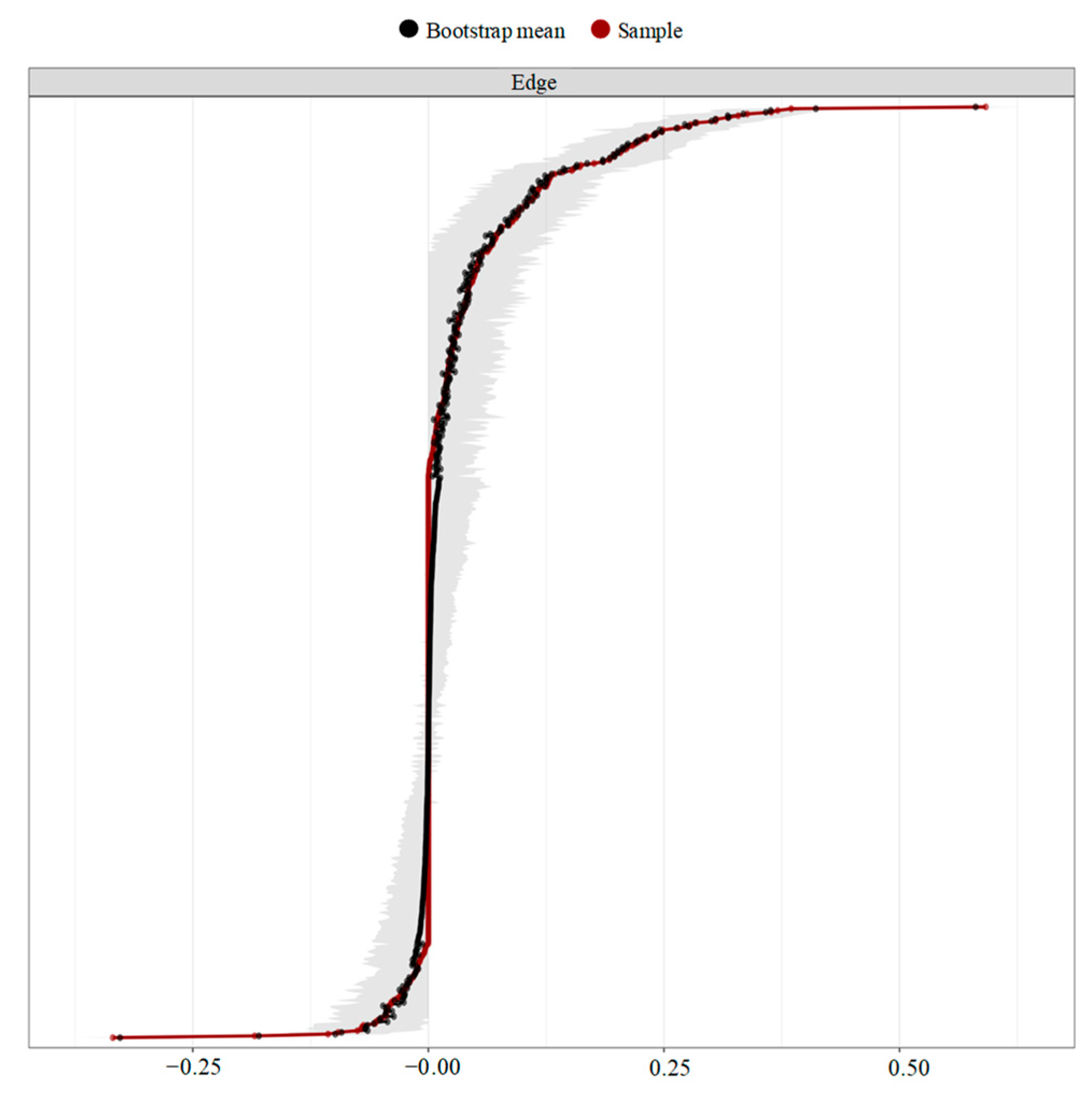Exploring and Deepening the Facets of Mentalizing: The Integration of Network and Factorial Analysis Approaches to Verify the Psychometric Properties of the Multidimensional Mentalizing Questionnaire (MMQ)
Abstract
1. Introduction
1.1. The Multidimensional Mentalizing Questionnaire (MMQ): A Theoretically Based Measure for the Assessment of a Multifaceted Construct
- Automatic—Controlled mentalizing. Automatic (or implicit) mentalizing refers to operations of rapid processing requiring little or no effort, awareness, or intention [31]. It is the prevalent configuration in daily life and in normal social interactions that do not require higher levels of attention [32]. However, more complex demands for communication and collaboration may be the source of a shift to controlled (or explicit) mentalizing, which reflects slower processing operations and requires greater levels of effort, awareness, and intention: it is more reflective, conscious, and deliberate [31,33,34].
- Self—Other mentalizing. This axis describes two closely and ontogenetically intertwined dimensions: mentalizing the self refers to the ability to reflect on one’s own lived and emotional and physical experiences, while mentalizing about others is characterized by a focus on other people and refers to the ability to correctly understand the reasons behind the behavior of others [33,35].
- Internal—External mentalizing. Mentalization can imply making inferences based on internal or external indicators. Therefore, internal mentalizing is a process focused on the internal world (e.g., thoughts, beliefs, desires, feelings, emotions, etc.). On the other hand, external mentalizing focuses on the characteristics and external manifestations of mental states (e.g., prosody, body posture, facial expressions, etc.) [33,36].
- Cognitive—Affective mentalizing. Cognitive mentalization finds its precursor in the concept of theory of mind [37] and describes the process of “thinking about thinking”, i.e., the ability to name, recognize, and reason about mental states [30]. Affective mentalization, on the other hand, implies the ability to understand the emotional dimension of mental states, and represents a necessary element for any genuine experience of empathy [30,38].
- (1)
- Reflexivity. This positive dimension refers to a propensity to understand the profound meaning of one’s life events, characterized by curiosity and the desire to analyze one’s experiences.
- (2)
- Ego-strength. This positive dimension refers to the ability to effectively manage daily difficulties and painful experiences, characterized by a sense of efficacy and realistic confidence.
- (3)
- Relational Attunement. This positive dimension refers to the inclination to tune into the emotional and cognitive states of others, deeply understanding their experiences.
- (4)
- Relational Discomfort. This negative dimension refers to experiences of discomfort and difficulty in the interpersonal sphere, linked to the perception of being misunderstood and damaged by others.
- (5)
- Distrust. This negative dimension refers to a closed-minded disposition towards the outside world, rigidity, and distrust in interpersonal relationships.
- (6)
- Emotional Dyscontrol. This negative dimension refers to a tendency towards impulsivity, accompanied by difficulty in managing and processing the emotional components of one’s experience.
1.2. Aims of the Study
- -
- Confirming the factor structure of the MMQ based on the Factor Analysis Approach to support the theoretically sound base of the questionnaire;
- -
- Establishing the cut-off points for both the MMQ total score and its subdimensions to allow clinicians to address specific aspects towards which to direct clinical and preventive activity;
- -
- Deepening the statistical characteristics of the MMQ by using a novel Network Analysis approach to assess the connection between items and their centrality properties.
2. Materials and Methods
2.1. Participants and Procedure
2.2. Measure
2.3. Data Analysis
3. Results
3.1. Factor Structure and Internal Consistency
3.2. Network Analysis
4. Discussion
4.1. Factor Analysis Approach
4.2. Network Analysis Approach
4.3. Limitations & Directions for Future Research
5. Conclusions
Author Contributions
Funding
Institutional Review Board Statement
Informed Consent Statement
Data Availability Statement
Conflicts of Interest
Appendix A
References
- Fonagy, P.; Bateman, A.W. Adversity, attachment, and mentalizing. Compr. Psychiatry 2016, 64, 59–66. [Google Scholar] [CrossRef] [PubMed]
- Bateman, A.; Fonagy, P. Psychotherapy for Borderline Personality Disorder: Mentalization-Based Treatment; Oxford University Press: Oxford, UK, 2004. [Google Scholar]
- Freeman, C. What is mentalizing? An overview. Br. J. Psychother. 2016, 32, 189–201. [Google Scholar] [CrossRef]
- Ballespí, S.; Vives, J.; Sharp, C.; Chanes, L.; Barrantes-Vidal, N. Self and other mentalizing polarities and dimensions of mental health: Association with types of symptoms, functioning and well-being. Front. Psychol. 2021, 12, 566254. [Google Scholar] [CrossRef]
- Fonagy, P.; Luyten, P.; Allison, E.; Campbell, C. What we have changed our minds about: Part 1. Borderline personality disorder as a limitation of resilience. Bord. Pers. Disord. Emot. Dysregul. 2017, 4, 11. [Google Scholar] [CrossRef] [PubMed]
- Schwarzer, N.H.; Nolte, T.; Fonagy, P.; Gingelmaier, S. Self-rated mentalizing mediates the relationship between stress and coping in a non-clinical sample. Psychol. Rep. 2022, 125, 742–762. [Google Scholar] [CrossRef]
- Stein, H. Does mentalizing promote resilience. In Handbook of Mentalization Based Treatment; John Wiley & Sons, Inc.: Hoboken, NJ, USA, 2006. [Google Scholar]
- Berthelot, N.; Lemieux, R.; Garon-Bissonnette, J.; Lacharité, C.; Muzik, M. The protective role of mentalizing: Reflective functioning as a mediator between child maltreatment, psychopathology and parental attitude in expecting parents. Child Abuse Negl. 2019, 95, 104065. [Google Scholar] [CrossRef] [PubMed]
- Borelli, J.L.; Brugnera, A.; Zarbo, C.; Rabboni, M.; Bondi, E.; Tasca, G.A.; Compare, A. Attachment comes of age: Adolescents’ narrative coherence and reflective functioning predict well-being in emerging adulthood. Attach. Hum. Dev. 2019, 21, 332–351. [Google Scholar] [CrossRef]
- Ballespí, S.; Vives, J.; Debbané, M.; Sharp, C.; Barrantes-Vidal, N. Beyond diagnosis: Mentalization and mental health from a transdiagnostic point of view in adolescents from non-clinical population. Psychiatry Res. 2018, 270, 755–763. [Google Scholar] [CrossRef]
- Luyten, P.; Campbell, C.; Allison, E.; Fonagy, P. The mentalizing approach to psychopathology: State of the art and future directions. Annu. Rev. Clin. Psychol. 2020, 16, 297–325. [Google Scholar] [CrossRef]
- Simonsen, C.B.; Jackobsen, A.G.; Grøntved, S.; Telléus, G.K. The mentalization profile in patients with eating disorders: A systematic review and meta-analysis. Nord. J. Psychiatry 2020, 74, 311–322. [Google Scholar] [CrossRef]
- Luyten, P.; Fonagy, P.; Lemma, A.; Target, M. Depression. In Handbook of Mentalizing in Mental Health Practice; Bateman, A.W., Fonagy, P., Eds.; American Psychiatric Publishing, Inc.: Arlington, VA, USA, 2012; pp. 385–417. [Google Scholar]
- Fischer-Kern, M.; Tmej, A.; Kapusta, N.D.; Naderer, A.; Leithner-Dziubas, K.; Loffler-Stastka, H.; Springer-Kremser, M. The capacity for mentalization in depressive patients: A pilot study. Z Psychosom. Med. Psychother. 2008, 54, 368–380. [Google Scholar] [CrossRef] [PubMed]
- Fischer-Kern, M.; Fonagy, P.; Kapusta, N.D.; Luyten, P.; Boss, S.; Naderer, A.; Blüml, V.; Leithner, K. Mentalizing in female inpatients with major depressive disorder. J. Nerv. Ment. Dis. 2013, 201, 202–207. [Google Scholar] [CrossRef] [PubMed]
- Sloover, M.; van Est, L.A.; Janssen, P.G.; Hilbink, M.; van Ee, E. A Meta-analysis of Mentalizing in Anxiety Disorders, Obsessive-Compulsive and Related Disorders, and Trauma-and Stressor Related Disorders. J. Anxiety Disord. 2022, 92, 102641. [Google Scholar] [CrossRef]
- Luyten, P.; Fonagy, P. Mentalizing and trauma. In Handbook of Mentalizing in Mental Health Practice, 2nd ed.; Bateman, A., Fonagy, P., Eds.; American Psychiatric Publishing: Washington, DC, USA, 2019; pp. 79–99. [Google Scholar]
- Suchman, N.E.; DeCoste, C.; Borelli, J.L.; McMahon, T.J. Does improvement in maternal attachment representations predict greater maternal sensitivity, child attachment security and lower rates of relapse to substance use? A second test of Mothering from the Inside Out treatment mechanisms. J. Subst. Abuse Treat. 2018, 85, 21–30. [Google Scholar] [CrossRef]
- Cosenza, M.; Ciccarelli, M.; Nigro, G. The steamy mirror of adolescent gamblers: Mentalization, impulsivity, and time horizon. Addict. Behav. 2019, 89, 156–162. [Google Scholar] [CrossRef] [PubMed]
- Debbané, M.; Salaminios, G.; Luyten, P.; Badoud, D.; Armando, M.; Solida Tozzi, A.; Fonagy, P.; Brent, B. Attachment, neurobiology, and mentalizing along the psychosis continuum. Front. Hum. Neurosci. 2016, 10, 406. [Google Scholar] [CrossRef]
- Allen, J.G.; Fonagy, P.; Bateman, A.W. Mentalizing in Clinical Practice; American Psychiatric Publishing, Inc.: Arlington, VA, USA, 2008. [Google Scholar]
- Stevens, J.S.; Jovanovic, T. Role of social cognition in post-traumatic stress disorder: A review and meta-analysis. Genes Brain Behav. 2019, 18, e12518. [Google Scholar] [CrossRef]
- Simonsen, S.; Euler, S. Avoidant and narcissistic personality disorders. In Handbook of Mentalizing in Mental Health Practice, 2nd ed.; Bateman, A., Fonagy, P., Eds.; American Psychiatric Publishing: Washington, DC, USA, 2019; pp. 351–367. [Google Scholar]
- Fonagy, P.; Bateman, A. The development of borderline personality disorder-A mentalizing model. J. Pers. Disord. 2008, 22, 4–21. [Google Scholar] [CrossRef]
- Fonagy, P.; Target, M.; Steele, H.; Steele, M. Reflective-Functioning Manual Version 5 for Application to Adult Attachment Interviews; University College London: London, UK, 1998. [Google Scholar]
- Gagliardini, G.; Gullo, S.; Teti, A.; Colli, A. Personality and mentalization: A latent profile analysis of mentalizing problematics in adult patients. J. Clin. Psychol. 2022, 79, 514–530. [Google Scholar] [CrossRef]
- Gagliardini, G.; Gullo, S.; Tinozzi, V.; Baiano, M.; Balestrieri, M.; Todisco, P.; Schirone, T.; Colli, A. Mentalizing subtypes in eating disorders: A latent profile analysis. Front. Psychol. 2020, 11, 564291. [Google Scholar] [CrossRef]
- Malda-Castillo, J.; Browne, C.; Perez-Algorta, G. Mentalization-based treatment and its evidence-base status: A systematic literature review. Psychol. Psychother. Theory Res. Pract. 2019, 92, 465–498. [Google Scholar] [CrossRef] [PubMed]
- Gori, A.; Arcioni, A.; Topino, E.; Craparo, G.; Lauro Grotto, R. Development of a New Measure for Assessing Mentalizing: The Multidimensional Mentalizing Questionnaire (MMQ). J. Pers. Med. 2021, 11, 305. [Google Scholar] [CrossRef] [PubMed]
- Bateman, A.; Fonagy, P.E. Handbook of Mentalizing in Mental Health Practice, 2nd ed.; American Psychiatric Publishing, Inc.: Washington, DC, USA, 2019. [Google Scholar]
- Allen, J.G. Mentalizing. In Practice in Handbook of Mentalization-Based Treatment; Allen, J.G., Fonagy, P., Eds.; John Wiley & Sons: West Sussex, UK, 2006; pp. 3–30. [Google Scholar]
- Jurist, E.L.; Slade, A.E.; Bergner, S.E. Mind to Mind: Infant Research, Neuroscience, and Psychoanalysis; Other Press: New York, NY, USA, 2011; Volume 39, pp. 116–118. [Google Scholar] [CrossRef]
- Lieberman, M.D. Social cognitive neuroscience: A review of core processes. Annu. Rev. Psychol. 2007, 58, 259–289. [Google Scholar] [CrossRef] [PubMed]
- Mayes, L.C. Arousal regulation, emotional flexibility, medial amygdala function, and the impact of early experience: Comments on the paper of Lewis et al. Ann. N. Y. Acad. Sci. 2006, 1094, 178–192. [Google Scholar] [CrossRef]
- Luyten, P.; De Meulemeester, C.; Fonagy, P. The self–other distinction in psychopathology: Recent developments from a mentalizing perspective. In The Neural Basis of Mentalizing; Gilead, M., Ochsner, K.N., Eds.; Springer: New York, NY, USA, 2021; pp. 659–680. [Google Scholar]
- Fonagy, P.; Luyten, P. A developmental, mentalization-based approach to the understanding and treatment of borderline personality disorder. Dev. Psychopathol. 2009, 21, 1355–1381. [Google Scholar] [CrossRef]
- Baron-Cohen, S.; Golan, O.; Chakrabarti, B.; Belmonte, M. Social cognition and autism spectrum conditions. In Social Cognition and Developmental Psychopathology; Sharp, C., Fonagy, P., Goodyer, I., Eds.; Oxford University Press: Oxford, UK, 2008; pp. 29–56. [Google Scholar]
- Arioli, M.; Cattaneo, Z.; Ricciardi, E.; Canessa, N. Overlapping and specific neural correlates for empathizing, affective mentalizing, and cognitive mentalizing: A coordinate-based meta-analytic study. Hum. Brain Mapp. 2021, 42, 4777–4804. [Google Scholar] [CrossRef]
- Swenson, C.R.; Choi-Kain, L.W. Mentalization and dialectical behavior therapy. Am. J. Psychother. 2015, 69, 199–217. [Google Scholar] [CrossRef]
- Fonagy, P.; Bateman, A.; Luyten, P. Introduction and overview. In Handbook of Mentalizing in Mental Health Practice, 2nd ed.; Bateman, A., Fonagy, P., Eds.; American Psychiatric Publishing: Washington, DC, USA, 2019; pp. 3–41. [Google Scholar]
- Luyten, P.; Fonagy, P. The neurobiology of mentalizing. Pers. Disord. Theory Res. Treat. 2015, 6, 366–379. [Google Scholar] [CrossRef]
- Denniston, M.M.; Klevens, R.M.; Mcquillan, G.M.; Jiles, R.B. Awareness of infection, knowledge of hepatitis C, and medical follow-up among individuals testing positive for hepatitis C: National Health and Nutrition Examination Survey 2001–2008. Hepatology 2012, 55, 1652–1661. [Google Scholar] [CrossRef]
- Zarotti, N.; Simpson, J.; Fletcher, I.; Squitieri, F.; Migliore, S. Exploring emotion regulation and emotion recognition in people with presymptomatic Huntingtons disease: The role of emotional awareness. Neuropsychologia 2018, 112, 1–9. [Google Scholar] [CrossRef]
- Luyten, P.; Van Houdenhove, B.; Lemma, A.; Target, M.; Fonagy, P. A mentalization-based approach to the understanding and treatment of functional somatic disorders. Psychoanal. Psychother. 2012, 26, 121–140. [Google Scholar] [CrossRef]
- Volkert, J.; Hauschild, S.; Taubner, S. Mentalization-based treatment for personality disorders: Efficacy, effectiveness, and new developments. Curr. Psychiatry Rep. 2019, 21, 25. [Google Scholar] [CrossRef] [PubMed]
- Kim, H.Y. Statistical notes for clinical researchers: Assessing normal distribution (2) using skewness and kurtosis. Restor. Dent. Endod. 2013, 38, 52–54. [Google Scholar] [CrossRef] [PubMed]
- Mulaik, S.A. Foundations of Factor Analysis; CRC Press: Boca Raton, FL, USA, 2009. [Google Scholar]
- Hooper, D.; Coughlan, J.; Mullen, M.R. Structural equation modeling: Guidelines for determining model fit. Electron. J. Bus. Res. Methods 2008, 6, 53–59. [Google Scholar]
- Hu, L.T.; Bentler, P.M. Cutoff criteria for fit indexes in covariance structure analysis: Conventional criteria versus new alternatives. Struct. Equ. Modeling 1999, 6, 1–55. [Google Scholar] [CrossRef]
- Kline, R.B. Principles and Practice of Structural Equation Modeling; Guilford Publications: New York, NY, USA, 2015. [Google Scholar]
- Fabrigar, L.R.; Wegener, D.T.; MacCallum, R.C.; Strahan, E.J. Evaluating the use of exploratory factor analysis in psychological research. Psychol. Methods 1999, 4, 272–299. [Google Scholar] [CrossRef]
- Kock, F.; Berbekova, A.; Assaf, A.G. Understanding and managing the threat of common method bias: Detection, prevention and control. Tour. Manag. 2021, 86, 104330. [Google Scholar] [CrossRef]
- Jackson, D.L.; Gillaspy, J.A., Jr.; Purc-Stephenson, R. Reporting practices in confirmatory factor analysis: An overview and some recommendations. Psychol. Methods 2009, 14, 6–23. [Google Scholar] [CrossRef]
- Byrne, B.M. Structural Equation Modeling with AMOS: Basic Concepts, Applications, and Programming, 2nd ed.; Taylor and Francis Group: New York, NY, USA, 2020. [Google Scholar]
- Cronbach, L.J. Coefficient alpha and the internal structure of tests. Psychometrika 1951, 16, 297–334. [Google Scholar] [CrossRef]
- McDonald, R.P. Test Theory: A Unified Treatment; Psychology Press: London, UK, 2013. [Google Scholar]
- Henseler, J.; Ringle, C.M.; Sarstedt, M. A new criterion for assessing discriminant validity in variance-based structural equation modeling. J. Acad. Mark. Sci. 2015, 43, 115–135. [Google Scholar] [CrossRef]
- Gaskin, J.; James, M. HTMT Plugin for AMOS. 2019. Available online: http://statwiki.kolobkreations.com/index.php?title=Plugins (accessed on 30 September 2021).
- Burger, J.; Isvoranu, A.-M.; Lunansky, G.; Haslbeck, J.M.B.; Epskamp, S.; Hoekstra, R.H.A.; Fried, E.; Borsboom, D.; Blanken, T. Reporting standards for psychological network analyses in cross-sectional data. Psychol. Methods 2022. [Google Scholar] [CrossRef]
- Ferguson, C.J. An effect size primer: A guide for clinicians and researchers. In Methodological Issues and Strategies in Clinical Research; Kazdin, A.E., Ed.; American Psychological Association: Washington, DC, USA, 2016; pp. 301–310. [Google Scholar] [CrossRef]
- Opsahl, T.; Agneessens, F.; Skvoretz, J. Node centrality in weighted networks: Generalizing degree and shortest paths. Soc. Netw. 2010, 32, 245–251. [Google Scholar] [CrossRef]
- Epskamp, S.; Borsboom, D.; Fried, E.I. Estimating psychological networks and their accuracy: A tutorial paper. Behav. Res. Methods 2018, 50, 195–212. [Google Scholar] [CrossRef] [PubMed]
- Ridenour, J.; Knauss, D.; Hamm, J.A. Comparing Metacognition and Mentalization and Their Implications for Psychotherapy for Individuals with Psychosis. J. Contemp. Psychother. 2019, 49, 79–85. [Google Scholar] [CrossRef]
- Fonagy, P.; Luyten, P.; Allison, E.; Campbell, C. Mentalizing, epistemic trust and the phenomenology of psychotherapy. Psychopathology 2019, 52, 94–103. [Google Scholar] [CrossRef] [PubMed]
- Allen, J.G. Mentalizing in the Development and Treatment of Attachment Trauma; Routledge: London, UK, 2018. [Google Scholar]
- Allen, J.G.; Fonagy, P. The Handbook of Mentalization-Based Treatment; John Wiley & Sons: Hoboken, NJ, USA, 2006. [Google Scholar]
- Markowitz, J.C.; Milrod, B.; Luyten, P.; Holmqvist, R. Mentalizing in interpersonal psychotherapy. Am. J. Psychother. 2019, 72, 95–100. [Google Scholar] [CrossRef] [PubMed]
- Salvatore, G.; Dimaggio, G.; Popolo, R.; Lysaker, P.H. Deficits in mindreading in stressful contexts and their relationships to social withdrawal in schizophrenia. Bull. Menninger Clin. 2008, 72, 191–209. [Google Scholar] [CrossRef]
- Borsboom, D.; Cramer, A.O. Network analysis: An integrative approach to the structure of psychopathology. Annu. Rev. Clin. Psychol. 2013, 9, 91–121. [Google Scholar] [CrossRef]
- Moriguchi, Y.; Ohnishi, T.; Lane, R.D.; Maeda, M.; Mori, T.; Nemoto, K.; Matsuda, H.; Komaki, G. Impaired self-awareness and theory of mind: An fMRI study of mentalizing in alexithymia. Neuroimage 2006, 32, 1472–1482. [Google Scholar] [CrossRef]
- Subic-Wrana, C. Emotion regulation and mentalization in somatoform disorders. In Emotion Regulation and Well-Being; Nyklíček, I., Vingerhoets, A., Zeelenberg, M., Eds.; Springer: New York, NY, USA, 2011; pp. 245–260. [Google Scholar]
- Midgley, N.; Vrouva, I. Minding the Child: Mentalization-Based Interventions with Children, Young People, and Their Families; Routledge: New York, NY, USA, 2012. [Google Scholar]
- Fonagy, P.; Luyten, P.; Allison, E. Epistemic petrification and the restoration of epistemic trust: A new conceptualization of borderline personality disorder and its psychosocial treatment. J. Pers. Disord. 2015, 29, 575–609. [Google Scholar] [CrossRef]
- Fonagy, P.; Target, M. Playing with reality: I. Theory of mind and the normal development of psychic reality. Int. J. Psychoanal. 1996, 77, 217–233. [Google Scholar] [PubMed]






| Characteristics | M ± SD | N | % | |
|---|---|---|---|---|
| Age | 33.44 ± 13.284 | |||
| Sex | ||||
| Males | 387 | 23.6 | ||
| Females | 1253 | 76.4 | ||
| Marital Status | ||||
| Single | 1077 | 65.7 | ||
| Married | 305 | 18.6 | ||
| Cohabiting | 195 | 11.9 | ||
| Separated | 22 | 1.3 | ||
| Divorced | 39 | 2.4 | ||
| Widowed | 2 | 0.1 | ||
| Education | ||||
| Elementary School diploma | 2 | 0.1 | ||
| Middle School diploma | 91 | 5.5 | ||
| High School diploma | 637 | 38.8 | ||
| University degree | 510 | 31.1 | ||
| Master’s degree | 264 | 16.1 | ||
| Post-lauream specialization | 136 | 8.3 | ||
| Occupation | ||||
| Student | 536 | 32.7 | ||
| Working student | 274 | 16.7 | ||
| Artisan | 34 | 2.1 | ||
| Employee | 413 | 25.2 | ||
| Entrepreneur | 74 | 4.5 | ||
| Freelance | 93 | 5.7 | ||
| Manager | 28 | 1.7 | ||
| Trader | 40 | 2.4 | ||
| Retired | 34 | 2.1 | ||
| Unemployed | 114 | 7.0 |
| χ2 | df | p | NFI | TLI | CFI | RMSEA | SRMR | Models Comparison | Δχ2 | Δdf | p | |
|---|---|---|---|---|---|---|---|---|---|---|---|---|
| Six-Factor Model | 3309.18 | 477 | <0.001 | 0.90 | 0.90 | 0.91 | 0.06 | 0.06 | ||||
| - | - | - | - | |||||||||
| Higher-order Model | 3616.64 | 485 | <0.001 | 0.89 | 0.89 | 0.90 | 0.06 | 0.08 | ||||
| M1–M2 | 307.46 | 8 | <0.001 | |||||||||
| Unifactorial Model | 14,637.76 | 492 | <0.001 | 0.54 | 0.52 | 0.55 | 0.13 | 0.16 | ||||
| M1–M3 | 11,328.58 | 15 | <0.001 |
| Score | α | ω | HTMT Analysis | Cut-Off | |||||||
|---|---|---|---|---|---|---|---|---|---|---|---|
| 1 | 2 | 3 | 4 | 5 | Low Scores | Average Scores | High Scores | ||||
| MMQ total score | 0.90 | 0.88 | <108 | 108–132 | >132 | ||||||
| Positive Factors | |||||||||||
| 1. Reflexivity, | 0.92 | 0.93 | - | <34 | 34–43 | >43 | |||||
| 2. Ego-strength | 0.88 | 0.88 | 0.55 | - | <18 | 18–24 | >24 | ||||
| 3. Relational Attunement | 0.88 | 0.88 | 0.83 | 0.54 | - | <17 | 17–23 | >23 | |||
| Negative factors | |||||||||||
| 4. Relational Discomfort | 0.80 | 0.80 | 0.14 | 0.20 | 0.09 | - | <9 | 9–15 | >15 | ||
| 5. Distrust | 0.79 | 0.80 | 0.09 | 0.03 | 0.10 | 0.79 | - | <8 | 8–13 | >13 | |
| 6. Emotional Dyscontrol | 0.79 | 0.81 | 0.30 | 0.08 | 0.60 | 0.32 | 0.51 | <10 | 10–16 | >16 | |
| Network | Network | Network | |||||||||
|---|---|---|---|---|---|---|---|---|---|---|---|
| Item | B | C | S | Item | B | C | S | Item | B | C | S |
| MMQ1 | −1.41 | −0.86 | −1.21 | MMQ12 | 1.29 | −0.06 | 0.78 | MMQ23 | 1.12 | 1.71 | −0.09 |
| MMQ2 | 1.97 | 1.86 | 1.31 | MMQ13 | −0.74 | −0.82 | 0.46 | MMQ24 | −0.68 | −0.99 | −0.06 |
| MMQ3 | 0.28 | 2.03 | 1.80 | MMQ14 | −0.90 | −0.04 | −1.81 | MMQ25 | −0.79 | −0.71 | 0.63 |
| MMQ4 | −1.13 | −1.16 | −1.24 | MMQ15 | −0.90 | −0.46 | −0.50 | MMQ26 | −0.40 | −0.22 | −0.37 |
| MMQ5 | 0.39 | −0.74 | 0.48 | MMQ16 | 0.17 | 0.40 | 1.55 | MMQ27 | −1.58 | −1.19 | −0.97 |
| MMQ6 | 0.73 | −0.19 | 1.50 | MMQ17 | −0.85 | −0.22 | −1.12 | MMQ28 | −0.34 | −0.58 | −0.41 |
| MMQ7 | 0.73 | 1.75 | 1.20 | MMQ18 | 1.01 | 0.83 | 0.46 | MMQ29 | −0.68 | −1.09 | 0.01 |
| MMQ8 | 0.73 | 0.42 | −0.32 | MMQ19 | 0.56 | 0.17 | −1.66 | MMQ30 | −1.07 | −1.00 | 0.92 |
| MMQ9 | 2.14 | 1.37 | 1.30 | MMQ20 | −0.23 | −0.39 | 0.31 | MMQ31 | 1.35 | 1.55 | 0.20 |
| MMQ10 | −0.57 | −0.48 | −0.53 | MMQ21 | 0.73 | 0.13 | −0.26 | MMQ32 | 1.07 | 1.16 | 0.80 |
| MMQ11 | −0.85 | −0.56 | −1.42 | MMQ22 | 0.00 | −0.22 | −0.56 | MMQ33 | −1.13 | −1.40 | −1.19 |
Disclaimer/Publisher’s Note: The statements, opinions and data contained in all publications are solely those of the individual author(s) and contributor(s) and not of MDPI and/or the editor(s). MDPI and/or the editor(s) disclaim responsibility for any injury to people or property resulting from any ideas, methods, instructions or products referred to in the content. |
© 2023 by the authors. Licensee MDPI, Basel, Switzerland. This article is an open access article distributed under the terms and conditions of the Creative Commons Attribution (CC BY) license (https://creativecommons.org/licenses/by/4.0/).
Share and Cite
Gori, A.; Topino, E. Exploring and Deepening the Facets of Mentalizing: The Integration of Network and Factorial Analysis Approaches to Verify the Psychometric Properties of the Multidimensional Mentalizing Questionnaire (MMQ). Int. J. Environ. Res. Public Health 2023, 20, 4744. https://doi.org/10.3390/ijerph20064744
Gori A, Topino E. Exploring and Deepening the Facets of Mentalizing: The Integration of Network and Factorial Analysis Approaches to Verify the Psychometric Properties of the Multidimensional Mentalizing Questionnaire (MMQ). International Journal of Environmental Research and Public Health. 2023; 20(6):4744. https://doi.org/10.3390/ijerph20064744
Chicago/Turabian StyleGori, Alessio, and Eleonora Topino. 2023. "Exploring and Deepening the Facets of Mentalizing: The Integration of Network and Factorial Analysis Approaches to Verify the Psychometric Properties of the Multidimensional Mentalizing Questionnaire (MMQ)" International Journal of Environmental Research and Public Health 20, no. 6: 4744. https://doi.org/10.3390/ijerph20064744
APA StyleGori, A., & Topino, E. (2023). Exploring and Deepening the Facets of Mentalizing: The Integration of Network and Factorial Analysis Approaches to Verify the Psychometric Properties of the Multidimensional Mentalizing Questionnaire (MMQ). International Journal of Environmental Research and Public Health, 20(6), 4744. https://doi.org/10.3390/ijerph20064744







